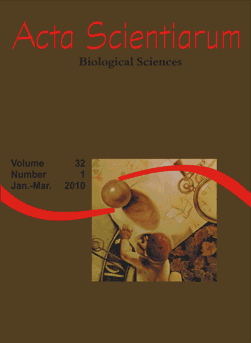<b>Application of molecular fingerprinting for analysis of a PAH-contaminated soil microbiota growing in the presence of complex PAHs</b> - DOI: 10.4025/actascibiolsci.v32i1.7575
Keywords:
Polycyclic aromatic hydrocarbons (PAHs), Biodegradation, PCR-DGGE, Microbial community
Abstract
Polycyclic aromatic hydrocarbons (PAHs) constitute a group of priority pollutants which are present at high concentrations in the soils of many industrial contaminated sites. Pollution by these compounds may stimulate growth of organisms able to live in these environments causing changes in the structure of the microbial community due to some cooperative process of metabolization of toxic compounds. A long-term PAH-contaminated soil was stored for several years and used to analyze the native microbiota regarding their ability to grow on pyrene, benzo[a]pyrene, as well as in mixtures of LMW- and HMW-PAHs. Molecular profiles of the microbial community was assessed by PCR-DGGE of 16S rRNA gene, and the number of bands observed in DGGE analyses was interpreted as dominant microbial members into the bacterial community. Results of PAH-contaminated soil microorganisms showed different profiles in the degradative dynamics when some nutrients were added. Predominant species may play a significative role while growing and surviving on PAHs, and some other metabolically active species have emerged to interact themselves in a cooperative catabolism of PAHs.Downloads
Download data is not yet available.
Published
2009-12-02
How to Cite
Silva, Ísis S., Menezes, C. R. de, Faria, A. F. de, Costa, J. G. da, Pepper, S., Britz, M., & Durrant, L. R. (2009). <b>Application of molecular fingerprinting for analysis of a PAH-contaminated soil microbiota growing in the presence of complex PAHs</b> - DOI: 10.4025/actascibiolsci.v32i1.7575. Acta Scientiarum. Biological Sciences, 32(1), 63-69. https://doi.org/10.4025/actascibiolsci.v32i1.7575
Issue
Section
Ecology and Limnology
DECLARATION OF ORIGINALITY AND COPYRIGHTS
I Declare that current article is original and has not been submitted for publication, in part or in whole, to any other national or international journal.
The copyrights belong exclusively to the authors. Published content is licensed under Creative Commons Attribution 4.0 (CC BY 4.0) guidelines, which allows sharing (copy and distribution of the material in any medium or format) and adaptation (remix, transform, and build upon the material) for any purpose, even commercially, under the terms of attribution.
Read this link for further information on how to use CC BY 4.0 properly.
0.6
2019CiteScore
31st percentile
Powered by 

0.6
2019CiteScore
31st percentile
Powered by 











1.png)




3.png)













